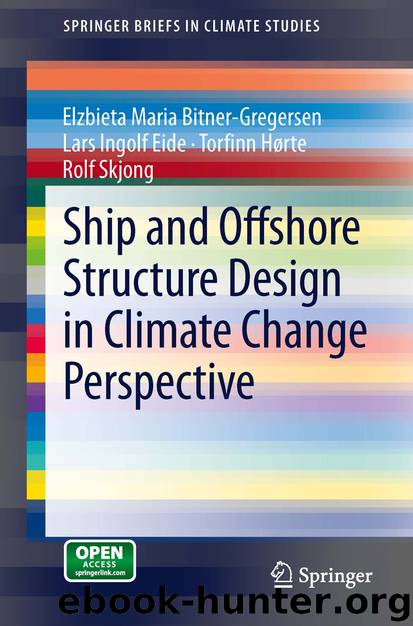Ship and Offshore Structure Design in Climate Change Perspective by Elzbieta Maria Bitner-Gregersen Lars Ingolf Eide Torfinn Hørte & Rolf Skjong

Author:Elzbieta Maria Bitner-Gregersen, Lars Ingolf Eide, Torfinn Hørte & Rolf Skjong
Language: eng
Format: epub
Publisher: Springer Berlin Heidelberg, Berlin, Heidelberg
3.3.1 Effect of Climate Model and Climate Forcing
Wang et al. (2004), Wang and Swail (2006a) as well as Caires et al. (2006) used one climate model (the Canadian CGCM2) for different emission scenarios. Wang and Swail (2006b), however, represented the average of three models for the emission scenarios A2 and B2. Their results confirm the qualitative picture and patterns of the other studies using only the CGCM2, but the magnitude of changes were generally smaller, indicating an influence of the choice of climate model on the end results. Indeed, Wang and Swail (2006b) found that the choice of climate model contributes most to wave projection uncertainty. This conclusion seems to be supported by Debernard and Røed (2008). Grabemann and Weisse (2008) also stated that there is a large uncertainty related to differences among climate models and found these to be larger than those related to differences among the climate forcing, or emission scenarios.
It is, however, important to note that the above studies mainly used the emission scenarios A2 and B2 (IS92a that was used in some cases is very similar to A2). These two scenarios do not represent the full variability of the IPCC scenarios and the results would probably have looked different if also the more extreme scenarios A1 and B1 were included (IPCC 2000). Both Debernard and Røed (2008) and Mori et al. (2010) used the A1B but combined with only one model, the BCCR model of the Bjerknes Center for Climate Research and the Japanese MRI-JMA, respectively. However A1B is an intermediate between A2 and B2 and closest to B2 and it is doubtful if this would shed more light on the contribution of different scenarios to the uncertainty.
It is difficult to quantify the uncertainties caused by different combinations of climate model and forcing scenario. Debernard and Røed (2008) combined the A2 and B2 scenarios with the Hadley Centre model HADAM3H, denoted as HADA2 and HADB2, and the Max Planck Institute model ECHAM4 with B2, denoted MPIB2, in addition to the combination of the BCCR model with the A1B scenario. Although they find some robust results, like the decrease in wave conditions southwest of Iceland and increase in the North and Norwegian Seas there are also indications that the uncertainties caused by different combinations may be of the same order as the projected change itself. Debernard and Røed (2008) showed quantile (qq) plots of scenario vs. control run and the relative increases of the ten largest sea states for four locations. E.g. for the K4 buoy location near Rockall west of Ireland, see map in Fig. 3.1, both the MPIB2 and HADB2 scenarios show changes in the three largest sea states of 7–8 % but with opposite signs (MPIB2 shows a decrease and HADB2 an increase). Different signs of the changes are also found at location M (Mike Station) in the Norwegian Sea and Tromsøflaket in the Barents Sea, although not as pronounced and consistent as for the K4 location. For Ekofisk in the North Sea the two scenarios agreed better.
Download
This site does not store any files on its server. We only index and link to content provided by other sites. Please contact the content providers to delete copyright contents if any and email us, we'll remove relevant links or contents immediately.
Whiskies Galore by Ian Buxton(41867)
Introduction to Aircraft Design (Cambridge Aerospace Series) by John P. Fielding(33064)
Small Unmanned Fixed-wing Aircraft Design by Andrew J. Keane Andras Sobester James P. Scanlan & András Sóbester & James P. Scanlan(32743)
Craft Beer for the Homebrewer by Michael Agnew(18140)
Turbulence by E. J. Noyes(7935)
The Complete Stick Figure Physics Tutorials by Allen Sarah(7307)
Kaplan MCAT General Chemistry Review by Kaplan(6866)
The Thirst by Nesbo Jo(6826)
Bad Blood by John Carreyrou(6543)
Modelling of Convective Heat and Mass Transfer in Rotating Flows by Igor V. Shevchuk(6391)
Learning SQL by Alan Beaulieu(6208)
Weapons of Math Destruction by Cathy O'Neil(6139)
Man-made Catastrophes and Risk Information Concealment by Dmitry Chernov & Didier Sornette(5921)
Digital Minimalism by Cal Newport;(5661)
Life 3.0: Being Human in the Age of Artificial Intelligence by Tegmark Max(5474)
iGen by Jean M. Twenge(5366)
Secrets of Antigravity Propulsion: Tesla, UFOs, and Classified Aerospace Technology by Ph.D. Paul A. Laviolette(5309)
Design of Trajectory Optimization Approach for Space Maneuver Vehicle Skip Entry Problems by Runqi Chai & Al Savvaris & Antonios Tsourdos & Senchun Chai(5011)
Electronic Devices & Circuits by Jacob Millman & Christos C. Halkias(4907)
